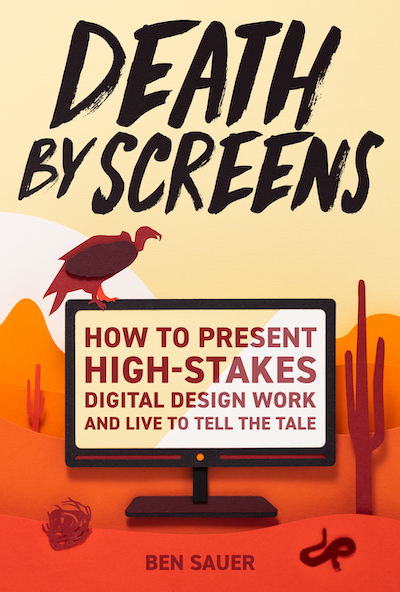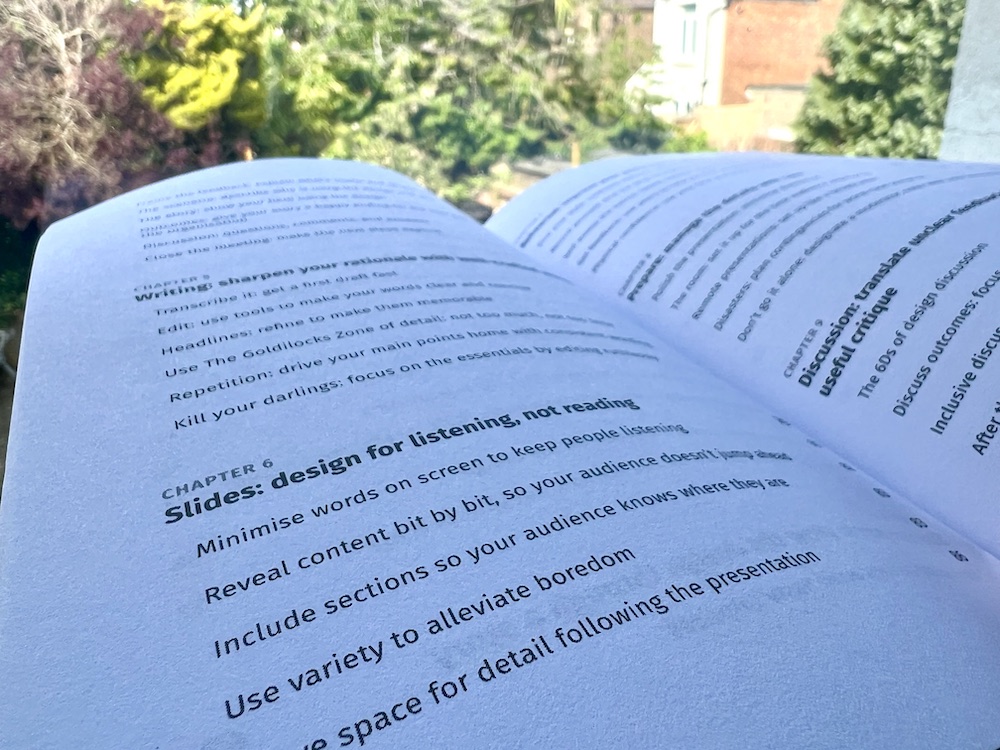




The secret of explaining your work isn't a series of screens or slides — it's the story you tell.
Death by Screens will teach how to avoid boring your audience with screen after screen. They'll get that elusive 'it': why you've designed it that way, not just what you've designed.
You'll learn what to say, what to show, in what order, how to do it with confidence, and how to have productive conversations with stakeholders.
Whether you're presenting in a high-stakes scenario or not, Death by Screens teaches you how to be a strong communicator, vital to developing a successful design career.
Presenting soon?
Get this book. Death by Screens is highly practical, with very little theory - you'll be a better presenter just by reading the table of contents.


About the author
Ben Sauer is a product and design leader, author and speaker.
As a UX Designer at the award-winning agency Clearleft, one of the first UX agencies in the world, Ben worked with clients such as the BBC and Tesco. His design for Evo magazine won Apple's Newsstand App of the Year.
Ben worked at Babylon Health as a Director of Product leading a team of 100 on AI-based products worth $100m+.
He’s a seasoned writer and blogger, contributing writing to books like The Great Redesign, and Meeting Design. He’s spoken at numerous events and companies around the world: The Economist, The NEXT Conference, VW + Audi, UX London, Penguin Random House, and many others.
Ben has trained teams worldwide in design, with his methods being adopted by teams at Amazon and the BBC. During his time teaching for O’Reilly, he taught people at NASA.
Table of Contents
1. Introduction: Death by Screens
- This book: how it can help you
- Why stories work: people are hard-wired to pay attention to them
2. First steps: prepare early to save time later
- Know your stakeholders: map your audience's concerns and expertise
- Choose your setting: take control of where, when, and how you present
- Send the invite: attract constructive input by managing expectations
- Start with structure: work on the slides later
3. Structure Part I: set the scene
- Introductions and welcome: set yourself up as the host
- The whys: why this work, why now, and why this meeting
- The attention-grabber: use a surprising quote, quiz, or story to engage your audience
- Principles: explain how you approached the design
- Share your insights: show what you learned, not your process
4. Structure Part II: show the design through a story
- Warnings and caveats: avoid nasty surprises
- Frame the feedback: explain what's useful and what's not
- The scenario: describe who is using the design and why
- The story: show your hero using the design
- Outcomes: give your story a happy ending for the user and the organisation
- Discussion: questions, comments, and answers
- Close the meeting: make the next steps explicit
5. Writing: sharpen your rationale with well-crafted words
- Transcribe it: get a first draft fast
- Edit: use tools to make your words clear and concise
- Headlines: refine to make them memorable
- Use the Goldilocks Zone of detail: not too much, not too little
- Repetition: drive your main points home with consistent wording
- Kill your darlings: focus on the essentials by editing ruthlessly
6. Slides: design for listening, not reading
- Minimise words on screen to keep people listening
- Reveal content bit-by-bit: so your audience doesn't jump ahead
- Include sections: so they know where they are
- Use variety: to alleviate boredom
- Leave space for detail: following the presentation
7. Rehearse: Improve your performance with feedback
- Find your style: confident delivery comes in many flavours
- Record yourself: find out what to improve by recording a rehearsal
- Self-assess the basics: speed, volume, rhythm, and expression
- Get feedback: use peers to help you find problems you cannot see
- Physical confidence: use your face and body to engage the audience
8. Prepare: manage the details with care
- Polish the presentation: minimise distraction
- The room: set it up for the best audience experience
- Remote presentations: setup like a broadcaster
- Disasters: plan contingencies for worst-case scenarios
- Don't go it alone: designate a moderator, note-taker, and timekeeper
9. Discussion: translate unclear feedback into useful critique
- The 6Ds of design discussion: Deference, Detail, Determine, Delay, Document, and Delegate
- Discuss outcomes: focus on the 'why' of the work
- Inclusive discussion: get the most from everyone's input
- After the meeting: follow up with your stakeholders
10. Resilience: managing yourself and your feelings
- Prepare and practice: the best way to reduce anxiety
- Expect the unexpected: adapt when problems arise
- Self-awareness: reframe your negative thoughts
- Visualise: mentally rehearse the performance
- Ground yourself: use mindful breathing
Final thoughts
Useful extras
- The task checklist:
- Reduce communication debt: use recorded presentations and huddles
- Culture-fit: tailor the presentation to suit the organisation
Running a design team?
Get a bulk discount on Death by Screens for your team.



